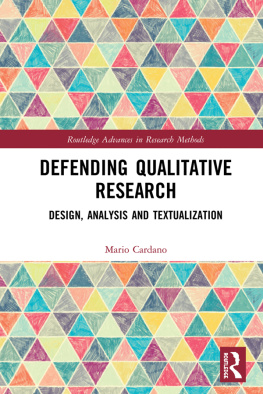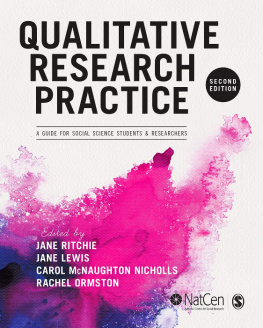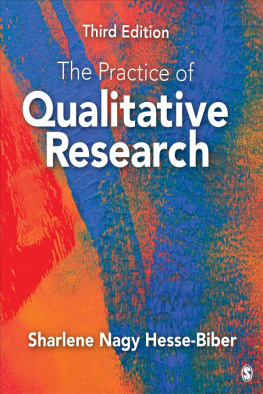SAGE Publications Ltd
1 Olivers Yard
55 City Road
London EC1Y 1SP
SAGE Publications Inc.
2455 Teller Road
Thousand Oaks, California 91320
SAGE Publications India Pvt Ltd
B 1/I 1 Mohan Cooperative Industrial Area
Mathura Road
New Delhi 110 044
SAGE Publications Asia-Pacific Pte Ltd
3 Church Street
#10-04 Samsung Hub
Singapore 049483
Adrian Holliday 2016
Second edition published 2007
Reprinted 2008, 2009, 2010, 2011, 2012, 2014
This third edition first published 2016
Apart from any fair dealing for the purposes of research or private study, or criticism or review, as permitted under the Copyright, Designs and Patents Act, 1988, this publication may be reproduced, stored or transmitted in any form, or by any means, only with the prior permission in writing of the publishers, or in the case of reprographic reproduction, in accordance with the terms of licences issued by the Copyright Licensing Agency. Enquiries concerning reproduction outside those terms should be sent to the publishers.
Library of Congress Control Number: 2015954641
British Library Cataloguing in Publication data
A catalogue record for this book is available from the British Library
ISBN 978-1-4739-5326-0
ISBN 978-1-4739-5327-7 (pbk)
Editor: Jai Seaman
Editorial assistant: Alysha Owen
Production editor: Tom Bedford
Copyeditor: Andy Baxter
Marketing manager: Ben Griffin-Sherwood
Cover design: Shaun Mercier
Typeset by: C&M Digitals (P) Ltd, Chennai, India
Printed and bound by CPI Group (UK) Ltd, Croydon, CR0 4YY
To Mehri and Shabnam, my most important discussants, and to my little grandchildren, Aara and Anoush, at two-and-a-half and five, the best examples of the rigorous hard work of researching culture in everyday life.
Preface
The focus of this third edition continues to be the task of squeezing the rich realities of social life into a written product. Part of the fascination with qualitative research is that the issues of researching and writing continue to preoccupy experienced researchers as well as those who are starting out. The book therefore deals with all levels of experience, who we are as researchers, who it is that we are researching, what is going on between us, and how solving the problems of research is not unlike solving the problems of how to make sense of human relations in everyday life.
The text speaks to a variety of audiences: students who are writing assignments from undergraduate essays to dissertations and theses, and professionals and academics who are writing papers or monographs for publication. I respond to issues that continue to be raised in tutorials, qualitative research classes, doctoral vivas, discussion with colleagues, and the recurring struggles we all face in getting back grades, comments and reviews from supervisors, journals and publishers. Throughout is the conviction that clarity in the composition of the written product means clarity in thinking, and that writing must be in ongoing dialogue with the research itself.
As an applied linguist I look at qualitative research as a discourse that is culturally and ideologically located. emphasises how the writer becomes a player in this discourse who must simultaneously participate and creatively assert her own space and presence, making the discourse work for her and perhaps changing it as she goes. My background in international language education and intercultural communication also brings sensitivity to global cultural politics. My own and my students research is mainly concerned with how we all perceive and can easily reduce the foreign Other through culturally chauvinistic description both at home and abroad. I therefore contextualise the role of the researcher within a politicised cultural space that belongs to people who are not researchers, but in which the researcher also becomes a member.
I draw on a number of examples of qualitative writing that include student assignments, dissertations, theses and published papers that are taken from a range of disciplines and professional areas. There is a slight preference for my own work and that of students with whom I have had regular contact, because this enables insider knowledge of the issues with which we struggle. The examples are international, representing researchers from 12 countries across the world. However, all are published or about to be submitted in international, English-medium journals or books, or written for assessment in English-medium universities. I make no attempt to address qualitative research beyond the domain of an English-speaking world. I also include interviews with some of the writers to get further background to why they did what they did; and three new writers were interviewed for the third edition.
I have purposely chosen good examples, but at the same time followed the principles of submission and emergence, which I introduce in , where I include an example of what not to do, in falling into the trap of cultural chauvinism; and this is taken from my own writing, then followed by how I learned from this and tried to put it right.
This third edition contains a revision of the whole text. The overall structure and many of the sections remain the same as in the previous editions, but with changes where my thinking has moved on or where there are better ways to express the original concepts. There is considerable re-framing and re-organisation in about the researcher as an active participant with an agenda that impacts on what happens and what is understood in the research setting.
I have kept most of the examples from the first and second editions because they continue to be excellent demonstrations of how qualitative writing should be carried out; and several examples have been added to support the new areas of concern. I have made only a few updates to the core references to works about qualitative research because the contribution they make is by no means out-dated. I have removed gratuitous literature review to make the text more personal. The implication of these decisions is that much of the basics of doing and writing qualitative research has not changed in the past 15 years. What perhaps has changed is the confidence and establishment of good practice. There continues however to be anxiety, especially but not only amongst novice writers, regarding the extent to which a creative management of subjectivity can take place and the role of the researcher voice in this process. I think that this can at least partly be attributed to continued lack of confidence in breaking from postpositivist preoccupations with objectivity and with data somehow being able to speak for itself. This realisation drives much of the new material regarding paradigm shift, the nature of the research setting and researcher voice as referred to above.














